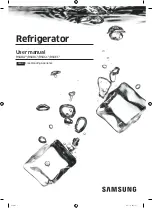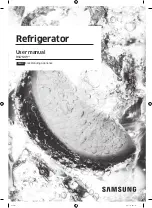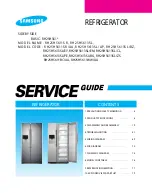
Brief introduction
Helpful hints and tips
Noises during Operation
The following noises are characteristic of
refrigeration appliances:
Clicks
Whenever the compressor switches on or
off, a click can be heard.
Humming
As soon as the compressor is in
operation, you can hear it humming.
Bubbling
When refrigerant flows into thin tubes,
you can hear bubbling or splashing noises.
Splashing
Even after the compressor has been
switched off, this noise can be heard for a short
time.
Energy saving tips
•
Do not install the appliance near cookers,
radiators or other sources of warmth.
•
Do not open the door too often or leave the
door open any longer than necessary.
•
Do not set temperature colder than necessary.
•
Make sure the side plates and back plate of
the appliance are with some distance from the
wall, follow the instructions relevant to installation.
•
If sketch map shows the right combination of
the drawers, crisper and shelves, do not adjust
the combination, it would result in more energy-
consuming.
Hints for fresh food refrigeration
To obtain the best performances:
•
Do not store warm foods or evaporating liquids
in the appliance.
•
Do cover or wrap the food, particularly if it has
a strong flavor or odor.
•
Position food so that air can circulate freely
around.
Hints for refrigeration
•
Meat (all types): wrap in polythene bags and
place on the glass shelf above the vegetable
drawer. For safety, store in this way only one or two
days at the most.
•
Cooked foods, cold dishes, etc…: these should
be covered and may be placed on any shelf.
•
Fruit and vegetables: these should be
thoroughly cleaned and placed in the special
draw(s) provided.
•
Butter and cheese: these should be placed in
aluminum foil or polythene bags to exclude as
much air as possible.
•
Milk bottles: these should have a cap and
should be stored in the bottle rack on the door.
Brief introduction
Cleaning and Care
For hygienic reasons the appliance interior,
including interior accessories, should be cleaned
regularly.
The fridge should be cleaned and maintained at
least every two months.
Notice!
•
Remove the food from the appliance before
cleaning. Store them in a cool place, well
covered.
•
Never clean the appliance with a steam
cleaner. Moisture could accumulate in electrical
components.
•
Hot vapors can lead to the damage of plastic
parts.
•
Ethereal oils and organic solvents can attack
plastic parts, e.g. lemon juice or the juice from
orange peel, butyric acid, cleanser that contain
acetic acid. Do not allow such substances to
come into contact with appliance parts.
•
Do not use any abrasive cleansers.
•
Clean the appliance and the interior
The appliance should not be connected to
the mains during cleaning. Before cleaning
switch the appliance off and remove the
plug from the mains, or switch off or turn out
the circuit breaker or fuse.
WARNING
Electrical Shock Hazard
16
Summary of Contents for EVCO1011
Page 78: ......
















































